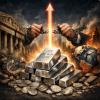
Breaking News
 Brighteon Broadcast News, Jan 7, 2026 - Doctors Replaced by AI...
Brighteon Broadcast News, Jan 7, 2026 - Doctors Replaced by AI...
 US Blockade Of Venezuela Triggers New Spike In Silver Price!
US Blockade Of Venezuela Triggers New Spike In Silver Price!
 Elon Musk Expects True AGI in 2026-2027 and Superintelligence About 2030...
Elon Musk Expects True AGI in 2026-2027 and Superintelligence About 2030...
 They Can't Stop The Unstoppable Rise Of Silver...
They Can't Stop The Unstoppable Rise Of Silver...
Top Tech News
 The First Production All-Solid-State Battery Is Here, And It Promises 5-Minute Charging
The First Production All-Solid-State Battery Is Here, And It Promises 5-Minute Charging
 See inside the tech-topia cities billionaires are betting big on developing...
See inside the tech-topia cities billionaires are betting big on developing...
 Storage doesn't get much cheaper than this
Storage doesn't get much cheaper than this
 Laser weapons go mobile on US Army small vehicles
Laser weapons go mobile on US Army small vehicles
 EngineAI T800: Born to Disrupt! #EngineAI #robotics #newtechnology #newproduct
EngineAI T800: Born to Disrupt! #EngineAI #robotics #newtechnology #newproduct
 This Silicon Anode Breakthrough Could Mark A Turning Point For EV Batteries [Update]
This Silicon Anode Breakthrough Could Mark A Turning Point For EV Batteries [Update]
 Travel gadget promises to dry and iron your clothes – totally hands-free
Travel gadget promises to dry and iron your clothes – totally hands-free
 Perfect Aircrete, Kitchen Ingredients.
Perfect Aircrete, Kitchen Ingredients.
 Futuristic pixel-raising display lets you feel what's onscreen
Futuristic pixel-raising display lets you feel what's onscreen
 Cutting-Edge Facility Generates Pure Water and Hydrogen Fuel from Seawater for Mere Pennies
Cutting-Edge Facility Generates Pure Water and Hydrogen Fuel from Seawater for Mere Pennies
Molten salt test loop to advance next-gen nuclear reactors

As next-generation nuclear reactors, known as Gen IV power plants, are developed, it is looking more and more likely that they will be of the molten salt variety. These plants swap out radioactive fuel rods and a water-coolant system with a salt slurry mixed with nuclear fuel and offer myriad benefits over their older brethren.
Such reactors are safer than old-school nuclear power plants, for example, because they operate at much lower pressures, making structural stress and failure in the event of an accident less of an issue.
Molten salt nuclear reactors (MSR) also have unique passive methods of preventing nuclear disasters. Some plants are equipped with what's known as a "freeze plug" in the reactor chamber. In the event of a power failure, the system keeping this chunk of salt in a frozen state fails, causing the plug to dissolve. This, in turn lets the salt/fuel slurry drain passively into underground tanks where it safely cools. On the other hand, if a reactor overheats, the expansion in the slurry spreads out the nuclear fuel making it harder for fission to continue, effectively shutting the plant down.
Additionally, molten nuclear reactors are more efficient than their predecessors, and are even potentially able to use waste materials that weren't completely spent in other nuclear processes. They also produce less waste that tends to decompose faster than traditional spent fuel rods and, because of their relatively small size, then can be deployed modularly as needed.
Combating corrosion
All that being said, one of the big challenges of MSRs is that hellishly hot molten salt tends to wreak havoc with whatever it comes into contact with.
Enter the joint project between Idaho National Labs (INL), Southern Company and TerraPower. That project, known as the Molten Chloride Reactor Experiment (MCRE), achieved a major milestone just last month, when it announced that it had used a prototype furnace to create a fuel based on denatured uranium at the rate of 18 kg (39 lb) per batch. That's a far cry from the three and a half tonnes the reactor will eventually need to reach criticality, but it's a start, and the fuel is being produced with 90% efficiency
Now the MCRE project has revealed the successful completion of its Molten Salt Flow Loop Test Bed, which aims to develop a reactor that can withstand the corrosive effects of molten salt.
This closed system is made from stainless steel with a slurry of lithium chloride-potassium chloride salts inside (yes, that is indeed the whole complicated name). As the salts circulate in the system, scientists are able to adjust properties of the slurry – such as temperature – without stopping the flow. This, in effect, means that they can study next-gen nuclear fuels as they circulate in real time.



